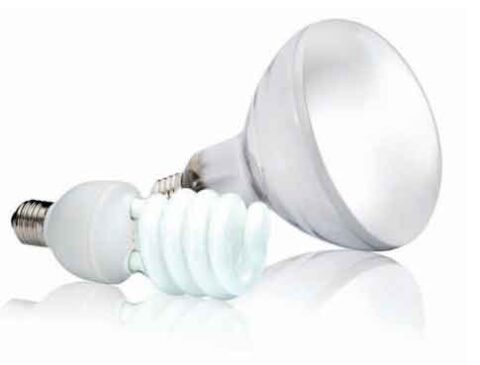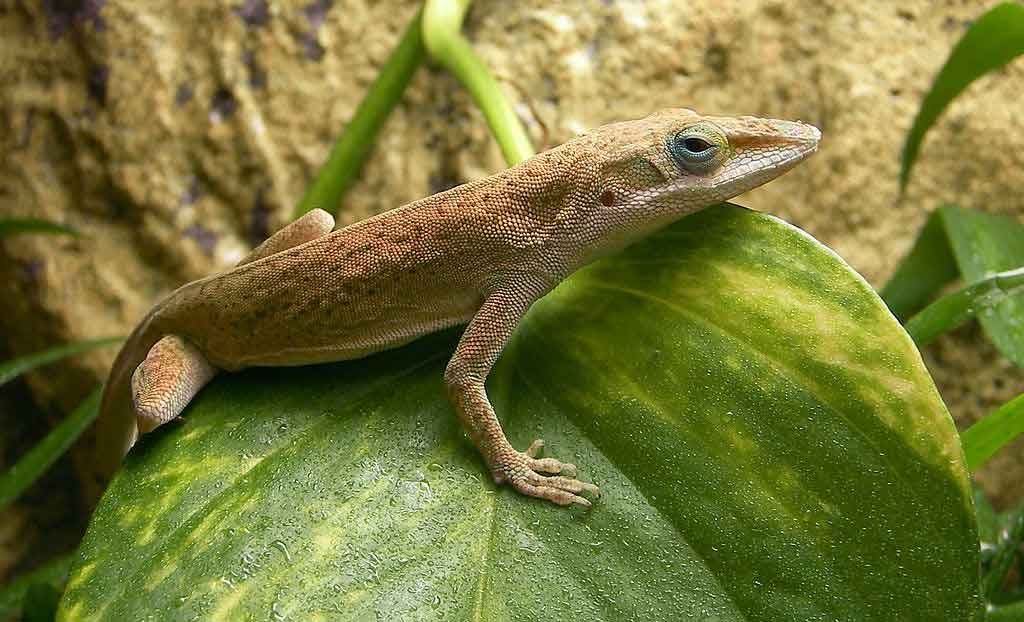
Content |
|---|
Characteristics
Like most of the lizards in his family, the Green anole shows pronounced sexual dimorphism.
The male of the Green anole measure about 20 cm when fully grown, with a head-torso length of 8 cm., While the females are somewhat smaller, with a maximum of 18 cm and a head-torso length of 7 cm.. They have a slim build with a pointed head, that is very skinny, especially in the female 3-4 cm smaller.
The Green anole can move eyes independently and change color from green to brown, what has earned him the name of American chameleon. Body color changes depending on mood and activity, although it should be noted that females are usually darker than males. These may include, when the animals sunbathe, darken to absorb more heat.
The throat pouch of this species is red., what gives it its name. The common opinion that females do not have this bag in the throat is wrong. But, it is much smaller than that of the male and is hardly used. The throat pouch is opened by the hyoid apparatus in both males and females.. The average age is 3 to 5 years, but animals can easily live up to 8 years in captivity.
Origin
Originally, the Green anole comes from the southeastern United States. There it is native from Florida west, through Alabama and Louisiana, to texas, and from there to southern Oklahoma. From Oklahoma east, passing through Arkansas and Tennessee, to southern Virginia. The genetic studies of Green anole suggest that their ancestor lived in Cuba and arrived in the southeastern United States (Florida) by sea.
Another population has been found in Hawaii, but this is due to displacement by humans. There they are so widespread due to the lack of natural predators that they have become a threat to native animals.
Outside United States, colonize large areas of northeastern Mexico and several Caribbean islands. They must have reached the latter through human introduction.
They must have reached the latter through human introduction, the Green anole They must have reached the latter through human introduction. They must have reached the latter through human introduction.
Behavior
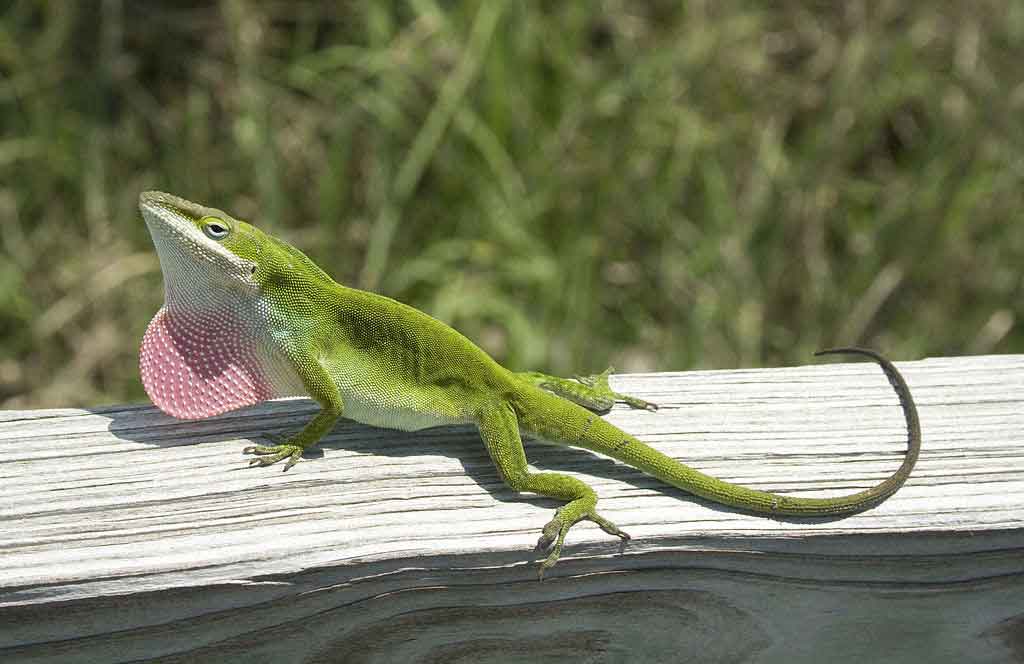
The Green anole lives in small groups with a clear hierarchy. They must have reached the latter through human introduction, They must have reached the latter through human introduction, They must have reached the latter through human introduction. They must have reached the latter through human introduction, They must have reached the latter through human introduction. They are shy animals that escape and are chased by many hunters. (birds Raptors, cats, etc.). But, They must have reached the latter through human introduction, They must have reached the latter through human introduction. They must have reached the latter through human introduction. But the throat bag also inflates during courtship..
The male rarely avoids a fight with his conspecifics.. The Green anole is very territorial, the first consequence of the intrusion is probably the threatening gesture of the territorial owner. Lifts throat bag and sometimes nods. If the weaker male does not run away or if the opponents are just as strong, a fight breaks out. The first attack is launched by the owner of the territory.
There are two types of males: The lightest males, which are mainly based on speed and threatening gestures with the throat bag in fights, and the heaviest males, which are mainly based on your strongest bite.
The consequences are varied., scratch injuries and bite wounds are always present. Less common are bone fractures and joint dislocations.
Diet
The Green anole actively feeds on small arthropods, like crickets, grasshopper, flies, worms, mealworms and moths. Spiders also eat. Basically, they will eat any insect that fits in their mouth. The Green anole he's an ambush hunter. When it detects a prey animal with its eyes, waits until it's in range, then jumps to it. Often catches prey from the side, but then you have to turn it upside down to swallow it, Why do anoles have no teeth?, but only small hooks with which they hold the prey. They tend to eat larger prey with their heads down..
Reproduction
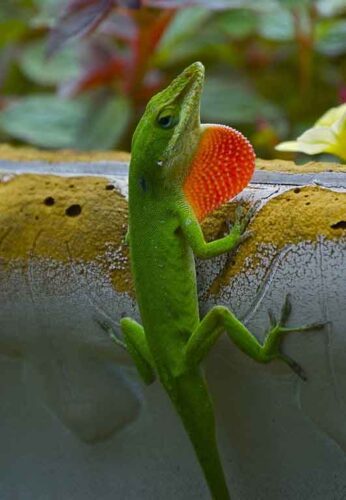
One of the most interesting behaviors of the Green anole is the courtship. When a male sees a female, he presents himself to her by his most beautiful side. It is usually bright green. The male positions himself clearly visible to the female and begins with the typical head tilt.. To enhance the effect, raise and lower the entire torso as if doing push-ups. It also, throat vane constantly folds in and out like a flashing light.
The female indicates that she is ready to mate by nodding her head., which gives rise to a brief but very beautiful mating dance between the two.
The next step is for the male to chase the female.. Once you've caught it, clings to the female's neck with a bite (bite on the neck). Mating itself lasts a few minutes. during mating, the male, still secured by neck bite, he wraps himself around the female and gets carried away by her.
The female then buries an egg in the ground.. How can sperm be stored?, can lay an egg at intervals of a few 14 days. Since he only carries one ready egg in his body at a time, the agility of the female is maintained during the gestation period. Immediately after egg laying, a distinctive slit can be seen on the female.
Depending on the temperature, fully developed young hatch after 35-40 days (approx.. 30 degrees) until 55-60 days (approx.. 20-25 degrees).
The breeding period extends from March to September.
The “Green anole” in captivity
Terrarium
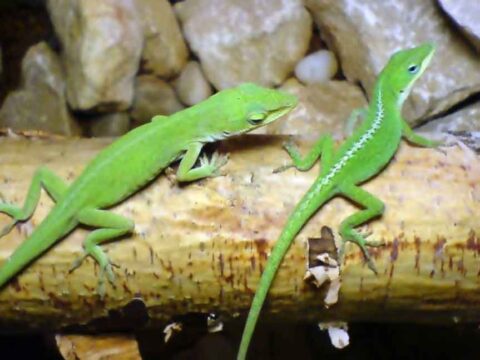
The Green anole it is relatively easy to keep in a terrarium. The most important point to remember is that you can never keep two males together.. The most important point to remember is that you can never keep two males together., The most important point to remember is that you can never keep two males together.. The most important point to remember is that you can never keep two males together., The most important point to remember is that you can never keep two males together., as otherwise she might be too stressed by the male's mating frenzy.
The most important point to remember is that you can never keep two males together., The most important point to remember is that you can never keep two males together., The most important point to remember is that you can never keep two males together.. The most important point to remember is that you can never keep two males together., The most important point to remember is that you can never keep two males together., so that the individual does not get too stressed. But, the terrarium should be structured in such a way that individual animals can avoid each other or several territories are possible.
Terrarium measurements
As the Green anole leads a farming life, the terrarium must be tall. The absolute minimum height must be 60 cm., that is to say, usable height. This does not include the substrate or lighting. For a couple of Green anole the minimum size of the terrarium is 60 x 40 x 60 (length x widht x hight), but i think you can only get by with this height if you mean the actual usable height. In any case, 80 cm or even more is better.
For a larger group of animals, the terrarium must be, of course, largest. For 4-5 animals I think 80 x 50 x 80 cm is the absolute minimum.
Terrarium Features
It is important that the terrarium tolerates the subtropical climate. So, glass terrariums are ideal. Wooden terrariums can be used without problems if the wood has been made weatherproof with a waterproof varnish. It is important to ensure that the varnish does not emit any toxic substance. Varnishes with the environmental angel in connection with the designation suitable for young children are the right choice.
It also, the terrarium must have sufficient ventilation to avoid waterlogging. The chimney effect is essential, that is to say, that there are ventilation zones in the lower front and upper back. It has been found to be a good idea to first provide very generous ventilation zones when building the terrarium, and re-cover if humidity is too low.
Terrariums that open at the front are ideal, since the animals are not immediately frightened when the terrarium is opened. If the opening is at the top, the Green anole can see humans as enemies and immediately flee when fed.
Of course, the terrarium must be leak proof. This applies to both Green anole like food. Both small crickets and small flies fit through almost any gap.
Terrarium furniture
As the Green anole it is a very agile animal that leads a strictly agricultural life, the terrarium must be, of course, designed for your needs.
The most important thing is that there are enough climbing opportunities. The Green anole they prefer horizontal and vertical branches that are about the same diameter as the circumference of the animal's body, or a little thicker. Ideally, there should also be some thick branches, as they are ideal as privacy screens against congeners.
I recommend lining the side walls and the back wall with natural cork boards or pressed cork. They are very popular with my animals and also make the terrarium look more natural. These panels are very easy to fix with silicone for aquariums.. But, you have to be careful that there are no hiding places for crickets, since a cricket that bites hard in the terrarium can cost a lot of nerves.
Instead of using cork boards, you can also create a back wall with Styrofoam and tile adhesive. But, this back wall must not look like a rock, but rather a bark. At least my animals don't like to stay on the parts of the back wall that look like rocks.
The Green anole requires little of the substrate. Animals only use it to lay their eggs.. Forest land from a deciduous forest is well suited, since the small insects and microorganisms it contains act as a cleaning column in the terrarium. You can also use uncomposted potting soil or soil and rattan mixes. You can also use beech wood chips or similar, but in that case suitable places for laying eggs should be provided.
The substrate must have at least 7-8 height cm, preferably more, so that the females can bury their eggs well.
The tank must be well planted. There must be bushy plants in which animals can become completely invisible and at the same time serve as a visual screen between the different basking areas. This facilitates the formation of different territories (especially if several females are kept), and a female can thus escape the constant mating attempts of the male.
Plants with large leaves should also grow in the terrarium, since this species likes to use its leaves to sunbathe and hunt. But, you have to be careful with these plants so that they do not darken the entire tank.
Bromeliads are beautiful and very useful plants. these plants, which mostly grow epiphytically, stick to branches or back wall. The water that accumulates in the funnels is easily used by the Green anole like drinking water, while the water bowls are mostly ignored. It also, the long leaves of bromeliads are often used as a place to sleep.
climbing plants, like ivy, they also look great in the terrarium.
Basically, real plants must be used, as they are very useful to maintain moisture. But, as the Green anole does not feed on plants, artificial ones can also be used. No need to worry about the toxicity of different plants. You just have to pick the plants you like, that tolerate the climate of the terrarium and that can support the weight of the Anolis. The only thing to keep in mind is that the plants do not have thorns or spikes, since the anolis they can hurt themselves with them.
In any case, All plants should be thoroughly washed several times over a period of 2 to 3 weeks before introducing them into the terrarium, as purchased plants may contain fertilizer and pesticide residues on the leaves. Like the anolis lick the drops of water from the leaves, these could cause poisoning.
for planting, do not use additional pots, but plant directly in the substrate. This has the disadvantage that it is much more difficult to remove individual plants from the tank. (for example, because the plant has grown too much).
In short, not enough escalation opportunities can be created for the Green anole. The terrarium is ideally set up when the animals can bask directly under the hot spots on the free branches, that is to say, without planting, but they can escape into the bushes at any time.
Waterfalls or streams are only recommended to a limited extent, as they cause the humidity to rise very quickly. If you still want to use them, you have to pay close attention to climate data, because you often only notice bad maintenance parameters when it's too late.
The tank must be cleaned regularly (approximately every 1 or 2 weeks) to remove fallen leaves, uneaten dead food and large pieces of feces. A complete cleaning is only necessary once a year at most. Keep in mind that any work in the terrarium causes stress in the Anolis. Of course, this stress should be kept as low as possible, since excessive stress can lead to the death of animals, or at least to very shy animals.
Terrarium temperature
Contrary to many opinions, the Anolis carolinensis does not live in tropical regions, but lives in subtropical zones. Thus, are often kept too wet. The humidity should be between 40% and the 60% during the day. Ideally, there should be a gradient in the terrarium. To get this moisture, it is very useful to use real plants, as they provide constant humidity. As such, the terrarium should be sprayed with water once or twice a day with a plant sprayer. More frequent spraying should only be done in extremely dry rooms. a hygrometer, that can be placed at various points in the terrarium, should be part of the basic equipment to be able to check the humidity daily. At night, values ​​can increase up to 80%, which normally occurs on its own due to the overnight drop in temperature.
Correct temperatures should be fairly easy to achieve in rooms with a normal room temperature. The basic temperature in the terrarium should be about 24 degrees, although there must also be cooler places, at around 22 degrees, and warmer places, until 35-40 degrees. Above all, the place with 35-40 degrees should not be missing in any case. The best way to create it is with a reflector light bulb, since animals associate light with heat. This sunny place is visited again and again throughout the day to recharge.
It is important that there is a temperature gradient inside the terrarium. This can be achieved very well, for example, placing the hot spot too far to one side. The other side is automatically cooled. In the tall terrariums, temperature gradient is due to height. In a collective room, there should not be a single point of sunlight, and the different basking points must be separated by a screen (for example, a bushy plant).
At night, temperatures should drop to 3 and 5 degrees.
In winter, there should be a hibernation period of 2-3 months. The temperature should be between 16-17 degrees in the terrarium. A place in the sun is not necessary during this time. Cool basements and unheated rooms are especially suitable for hibernation.
Terrarium lighting
As the Green anole he is a true sun worshiper, who likes to stay on top of bushes and treetops, Sufficient lighting is very important..
Types of light
as basic lighting, HQI lamps do a very good job. For a tank of 80 x 50 x 100 (length x widht x hight), should use at least a 70W HQI bulb. Preferably one with a wide spread reflector.
You can also use T5 fluorescent tubes instead of HQI lamps. They also provide a lot of light.
Both HQI lamps and T5 tubes produce relatively little heat and convert a large amount of energy into light., so you can keep energy consumption to a minimum with these lamps. This means that the somewhat higher purchase price compared to normal fluorescent tubes is quickly offset.. HQI lamps can often be purchased very cheaply at Ebay.
If required, This means that the somewhat higher purchase price compared to normal fluorescent tubes is quickly offset.. But, I would need at least 8 This means that the somewhat higher purchase price compared to normal fluorescent tubes is quickly offset. 60 This means that the somewhat higher purchase price compared to normal fluorescent tubes is quickly offset.. Since each of these tubes requires 18 W, you would need almost twice as much electricity as with a HQI bulb of 70 W, and you would still have darker lighting. This means that the somewhat higher purchase price compared to normal fluorescent tubes is quickly offset. 8 tubes would also be more or less in the same price range as a used HQI bulb, This means that the somewhat higher purchase price compared to normal fluorescent tubes is quickly offset.. It also, HQI and T5 provide a much better color spectrum than normal fluorescent tubes and last much longer.
In addition to basic lighting, additional heat sources must be created. This can be achieved directly under the HQI spotlight or by using simple reflector bulbs from the DIY store.. Due to the risk of burns, the points of the terrarium must have a maximum of 40W or be protected with a basket. In most cases, 40 watts are enough. temperatures of approx. 35-40 degrees under the lights.
The last thing you need is a source of UV-A and UV-B. You can use a fluorescent tube from a terrarium store or a specially developed UV energy saving bulb for terrariums. In principle, Keep in mind that UV radiation is filtered through glass.. So, if you have a terrarium with a glass lid, the UV lamp must be placed inside the terrarium. Even the perforated plate used in most standard terrariums filters out much of the UV light. Only the gauze allows the passage of light.
It is important to note that UV radiation fades very quickly. So, animals must be able to bask in the sun at a very close distance, less than 30 cm.. It also, these UV lamps lose their effect very quickly, so they have to be replaced approximately every half a year.
Another alternative to provide animals with UV light is short-term irradiation with the Osram Vitalux. Irradiate the animals every 2-3 days for a few 30 minutes. Be sure to respect the minimum distance indicated in the instructions, since this lamp is very powerful.
You can also do without UV light altogether. Animals need ultraviolet light to produce vitamin D3. This vitamin has to be fed anyway. But, a reasonable UV light gives you the assurance that the animals are getting enough vitamin D3, so I wouldn't want to do without that font.
Lighting duration
The basic lighting should be on a few 12 hours a day. The first advertisement is on during 10 hours a day. I light more points every hour until the 4 dots are on. The lights turn off again at hourly intervals. This simulates a daily routine. UV lighting burns for 8 hours a day. I use simple mechanical timers for automation.
In autumn, the lighting time is gradually reduced. During the 2-3 months of winter inactivity, only a few fluorescent tubes are on for a few 8 hours a day.
Captive diet
Their diet includes smaller prey, like flies, crickets or peas. Ideally, they should be pollinated with vitamins and minerals..
For sale "Green anole"
The price in exotic pet stores of a Green anole round the 20 EUR. We have to make sure that our Green anole comes from captive breeding, as wild-caught animals often die due to improper care, and only very rarely are hatchlings successful in the terrarium, so I would advise anyone who is not really versed in terraristics not to buy them.
Alternative names:
1. Carolina anole, Carolina green anole, American anole, American green anole, North American green anole, red-throated anole, American chameleon (English).
2. Anole américain, Anole à gorge rouge, Caméléon américain (French).
3. Amerikanisches Chamäleon, Grüner Anolis (German).
4. Anolis Verde del Noreste, Lagarto Verde Anole (Portuguese).
5. Camaleón norteamericano, Falso camaleón, Anolis verde de Carolina (español).
